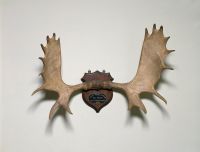The French naturalist Comte Georges-Louis de Buffon argued in a scientific publication that the New World's life forms -- plant, animal, and human -- were smaller and inferior to those of the Old, because the New World itself was inferior. America was, according to Buffon, "a land best suited for insects, reptiles, and feeble men."
Notes on the State of Virginia
This theory irritated Thomas Jefferson and inspired him to disprove it, which he did, point by point, in a book entitled Notes on the State of Virginia. In the chapter called "Productions Mineral, Vegetable and Animal," for instance, Jefferson used charts to demonstrate that animals domesticated in both the Old and New Worlds are consistently larger in America. In addition, Jefferson argued, the number of quadrupeds found only in America is four times greater than those found only in Europe, and a single of these uniquely American animals -- the buffalo -- outweighs the entire list of uniquely European quadrupeds combined! Throughout his life, Jefferson collected and displayed the bones, horns, and stuffed heads of various American animals, documenting the rich variety of life in the New World.
Sending A Moose To France
 Among Jefferson's greatest hopes for soundly refuting Buffon's theory was the American moose, which stood one-third taller than its European counterpart. While in France, Jefferson discussed the moose with Buffon, and then wrote two New Englanders that the "skin, the skeleton, and the horns of the Moose" would be "an acquisition here, more precious than you can imagine." John Sullivan complied with his request, and the beast arrived in France in September 1787. Within days, Jefferson presented Buffon with the evidence, along with a copy of Notes on the State of Virginia. Jefferson later told Daniel Webster that Buffon "promised in his next volume, to set these things right also: but he died directly afterwards."
Among Jefferson's greatest hopes for soundly refuting Buffon's theory was the American moose, which stood one-third taller than its European counterpart. While in France, Jefferson discussed the moose with Buffon, and then wrote two New Englanders that the "skin, the skeleton, and the horns of the Moose" would be "an acquisition here, more precious than you can imagine." John Sullivan complied with his request, and the beast arrived in France in September 1787. Within days, Jefferson presented Buffon with the evidence, along with a copy of Notes on the State of Virginia. Jefferson later told Daniel Webster that Buffon "promised in his next volume, to set these things right also: but he died directly afterwards."